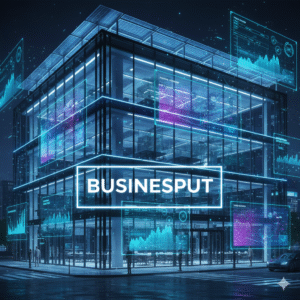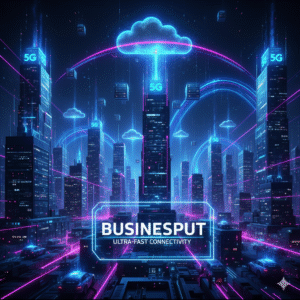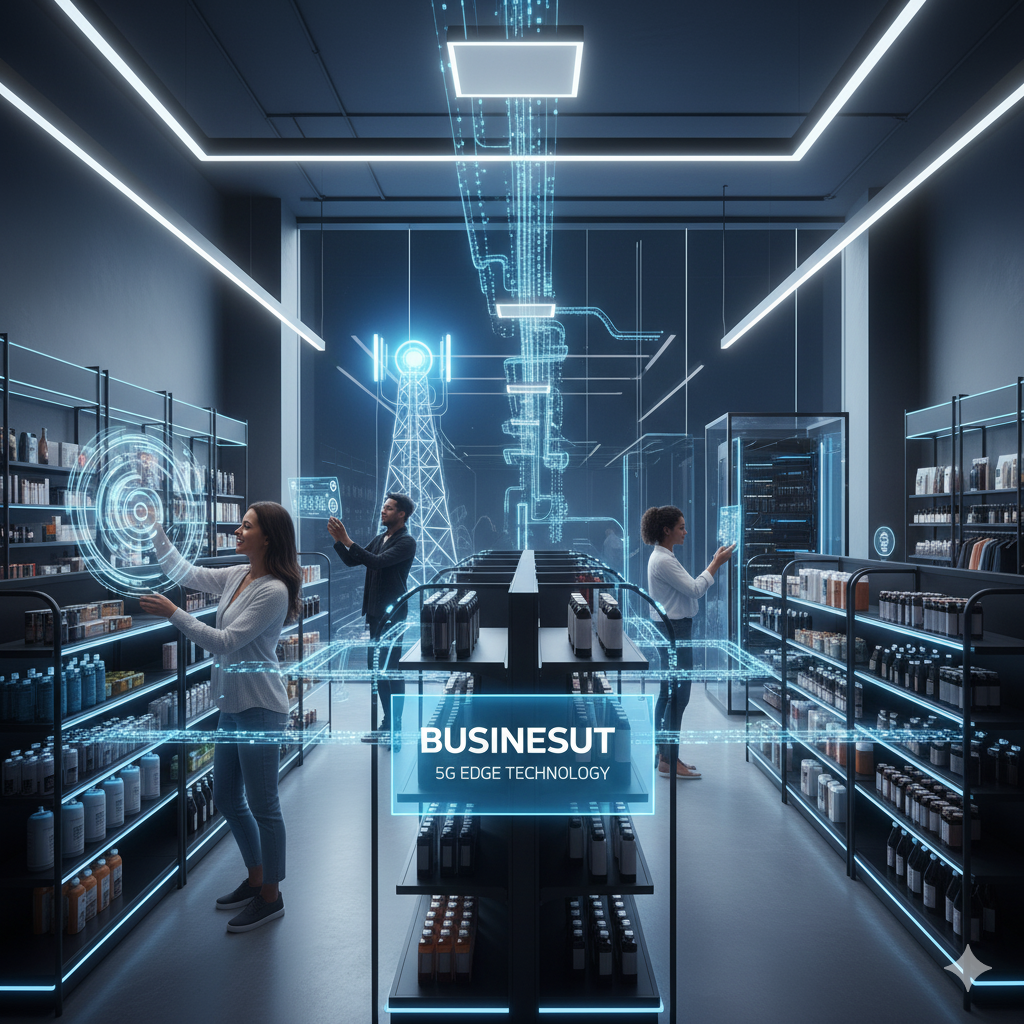⚡ The Power of 5G Edge Computing: Transforming Efficiency, Innovation & Connectivity
In today’s fast-paced digital world 🌍, data is everything — but speed, intelligence, and where that data is processed are the real game changers. That’s where 5G Edge Computing steps in, merging the ultra-fast capabilities of 5G networks with the instant processing power of edge technology.
In today’s hyperconnected world, speed is everything. 🏃♂️💨 From streaming videos to tracking deliveries, consumers expect instant results — and retail businesses are racing to keep up. But what’s fueling this new level of speed and intelligence? The answer lies in the powerful combination of 5G and Edge Computing. 📡💻
Together, they’re transforming the way retailers manage stores, track inventory, and enhance customer experiences. Let’s explore how this tech duo is shaping the future of retail. 🛍️🚀
Together, they’re redefining how industries — from retail to smart cities — operate efficiently, securely, and sustainably. Let’s explore how this powerful combination is shaping the future. 🚀
🌐 What is 5G Edge Computing?
Before diving into the retail impact, let’s break it down simply.
5G is the fifth generation of mobile networks — offering lightning-fast speeds, ultra-low latency (delay), and massive device connectivity. 📶
Edge Computing means processing data closer to where it’s generated — like in a store or warehouse — instead of sending everything to distant cloud servers. ☁️➡️🏬
When you combine these two, magic happens. 💫
You get real-time data processing and instant decision-making, enabling retailers to react on the spot.
Think of it like having a brain inside every store shelf, camera, and sensor — making split-second decisions without waiting for instructions from a distant cloud. 🧠⚙️
🌐 The Benefit of Edge Computing in 5G
The biggest benefit of edge computing in 5G is speed and proximity. 💨
In traditional systems, data travels long distances from devices to central cloud servers and back — causing latency (delays). Edge computing solves this by processing data locally, right near the data source.
When combined with 5G’s lightning-fast connectivity, this means:
-
⚡ Ultra-low latency — actions happen in milliseconds.
-
📊 Real-time decision-making — critical for automation, AR/VR, and autonomous systems.
-
🔒 Better security — sensitive data stays close, reducing risk.
-
🌱 Lower bandwidth use — only essential data is sent to the cloud.
In short, 5G + Edge equals faster, smarter, and more efficient digital ecosystems.

🛍️Use of Technology Enhance the Efficiency of Retail Business
Technology is revolutionizing retail — from how customers shop to how inventory is managed. 🏬✨
Here’s how:
-
Smart Inventory Management:
5G and edge-powered sensors track products in real time. Shelves automatically detect low stock and trigger restocking. 📦 -
Personalized Shopping:
AI combined with edge computing offers instant recommendations, AR fitting rooms, and customized promotions. 💅 -
Contactless & Seamless Checkout:
Just walk out stores like Amazon Go use 5G edge technology for instant billing and theft detection. -
Real-Time Analytics:
Edge systems analyze in-store data immediately, helping managers make quick decisions. -
Reduced Waste & Costs:
By improving efficiency and automation, technology reduces manpower needs and operational waste. 💰
This digital transformation helps businesses deliver smoother, faster, and more enjoyable customer experiences. 💖
🧩 Devices Improve the Efficiency and Security of IoT Networks
The Internet of Things (IoT) connects billions of smart devices — but managing all that data centrally is tough. That’s where edge devices shine. 🌟
Here’s how they boost efficiency and security:
-
⚙️ Local Data Processing: Instead of sending every piece of information to the cloud, edge devices filter and analyze it locally, saving bandwidth.
-
🔒 Enhanced Security: Sensitive data (like facial recognition or location info) doesn’t need to leave the device — reducing the risk of cyberattacks.
-
⚡ Low Latency: IoT systems like autonomous vehicles or smart factories can respond instantly without waiting for cloud instructions.
-
💡 Network Stability: Even if internet connectivity drops, edge devices can keep operating independently.
In essence, edge computing decentralizes intelligence — making IoT networks faster, safer, and more reliable.
🏢 Edge Computing Contribute to Energy Efficiency in Smart Buildings
Sustainability is a major goal for modern architecture 🌿, and edge computing is a hidden hero in achieving it.
Here’s how it helps smart buildings become energy-efficient:
-
Real-Time Energy Monitoring:
Sensors at the edge analyze data from lighting, heating, and cooling systems instantly — adjusting usage to save power. 💡 -
Predictive Maintenance:
Edge analytics detect when equipment like elevators or HVAC systems need service, reducing energy waste. 🛠️ -
Dynamic Control:
Buildings can automatically dim lights or reduce AC in unused spaces — all managed locally without lag. -
Reduced Data Transfer:
Since edge devices process data on-site, less energy is spent transmitting large datasets to cloud servers. ☁️
Smart buildings powered by 5G and edge computing are greener, cheaper, and more responsive — the future of sustainable living. 🌱
⚙️ Benefits of Using Edge Computing
Edge computing brings a world of advantages across industries. Let’s sum up the key benefits:
-
⚡ Ultra-low latency: Real-time performance for critical applications.
-
📊 Efficient bandwidth use: Only necessary data goes to the cloud.
-
🔒 Enhanced data security: Localized data processing reduces exposure risks.
-
💡 High reliability: Systems continue to function even if connectivity drops.
-
🌍 Scalability: Perfect for industries with millions of connected devices (like IoT).
-
💰 Cost efficiency: Less data transfer and cloud storage save money.
Whether it’s in retail, healthcare, transportation, or manufacturing — edge computing boosts productivity and responsiveness everywhere. 🌐

🚀 Innovation in Edge Computing Enhanced by 5G
5G has unlocked new levels of innovation in edge computing. Some cutting-edge examples include:
-
🏭 Smart Factories: Robots and AI systems communicate instantly, improving production speed and quality.
-
🚗 Autonomous Vehicles: 5G edge allows cars to exchange safety data in milliseconds — preventing accidents.
-
🛒 Retail Automation: AI cameras powered by edge servers detect empty shelves or misplaced products in real time.
-
🩺 Healthcare Monitoring: Wearable devices analyze health metrics locally and send alerts instantly during emergencies.
-
🕶️ AR/VR Applications: With minimal lag, 5G edge powers immersive virtual experiences for gaming, education, and retail.
These innovations mark the dawn of a hyperconnected world, where intelligence exists everywhere — not just in the cloud. ☁️✨
Technology 5G Use to Enhance Network Capacity and Efficiency
5G isn’t just faster than 4G — it’s smarter. 🧠
Here’s the tech behind its enhanced capacity and efficiency:
-
Massive MIMO (Multiple Input Multiple Output):
Uses multiple antennas to send and receive more data simultaneously — increasing speed and coverage. 📶 -
Network Slicing:
Divides a single 5G network into multiple “virtual networks” tailored for different needs (e.g., one for IoT, one for streaming). 🎛️ -
Beamforming:
Directs signals precisely to devices instead of broadcasting in all directions — improving energy use and signal quality. 📡 -
Edge Integration:
Processing data closer to users reduces congestion and ensures faster response times.
These features make 5G the backbone of next-gen connectivity, supporting billions of devices with unparalleled efficiency. 🌍
🧱 Three Layers of Edge Computing
Edge computing operates through three main layers, each responsible for different levels of processing:
-
Device Layer:
Sensors, IoT devices, and user gadgets that collect data (like cameras, thermostats, or wearables). 📲 -
Edge Layer:
Local servers or gateways process and analyze data close to its source. This layer ensures quick decisions and minimal latency. ⚙️ -
Cloud Layer:
The centralized data centers where large-scale analytics, storage, and long-term insights are handled. ☁️
Together, these layers form a seamless digital ecosystem — balancing speed, efficiency, and scalability.

🌍the Leader in Edge Computing
The race for edge computing leadership is global 🌎, and several tech giants are leading the charge:
-
Amazon Web Services (AWS) – Offers AWS Wavelength to integrate 5G and edge for ultra-low-latency applications.
-
Microsoft Azure Edge – Brings cloud services to local networks for faster and secure computing.
-
Google Distributed Cloud Edge – Focused on AI-powered applications and real-time analytics.
-
IBM Edge Application Manager – Known for enterprise-grade AI deployment across devices.
-
NVIDIA – Dominating with AI edge hardware and software platforms.
⚙️ Real-World Examples
Let’s look at some practical examples of how major players are already adopting this technology:
-
Walmart uses edge-enabled cameras and sensors to monitor inventory levels in real time.
-
Amazon Go stores rely on 5G-powered computer vision systems to enable cashier-less shopping. 🛒
-
Zara (Inditex) employs RFID and edge data systems for live inventory tracking across global stores.
-
Carrefour integrates IoT devices with edge servers to optimize supply chain and in-store operations.
These examples show that the retail future is not coming — it’s already here. ⚡
🔮 The Future of Retail with 5G Edge Computing
The future retail landscape will be:
-
Connected — every object, shelf, and customer linked in real time.
-
Predictive — systems will anticipate needs before they arise.
-
Personalized — each shopper will enjoy tailored experiences.
-
Autonomous — drones, robots, and AI assistants managing operations. 🤖
By 2030, experts predict that 5G edge computing will be the backbone of retail, supporting everything from cashier-less checkout to fully automated warehouses. 🏗️
Retailers that adopt early will lead in efficiency, sustainability, and customer trust.
Telecom leaders like Ericsson, Huawei, and Nokia are also crucial in building 5G edge infrastructure worldwide.
These pioneers are driving the shift toward a more decentralized, intelligent, and connected future. 💫
The convergence of 5G and Edge Computing is reshaping our digital world — enabling everything from smart cities to intelligent retail. 🏙️✨
It’s not just about speed — it’s about efficiency, security, sustainability, and innovation.
From the shelves in your local store to the systems running entire cities, edge computing is quietly powering a smarter, greener, and faster tomorrow. 🌍⚡




